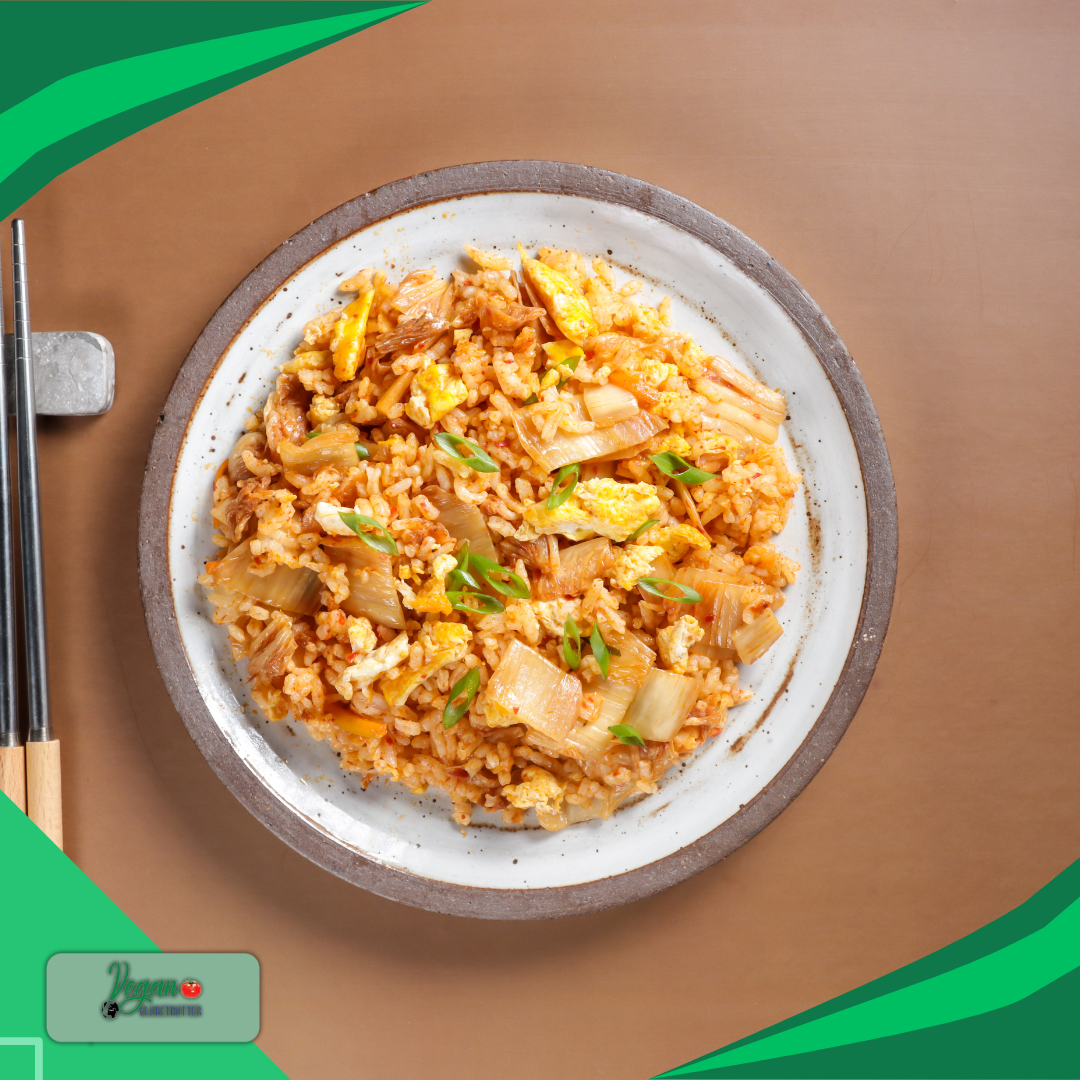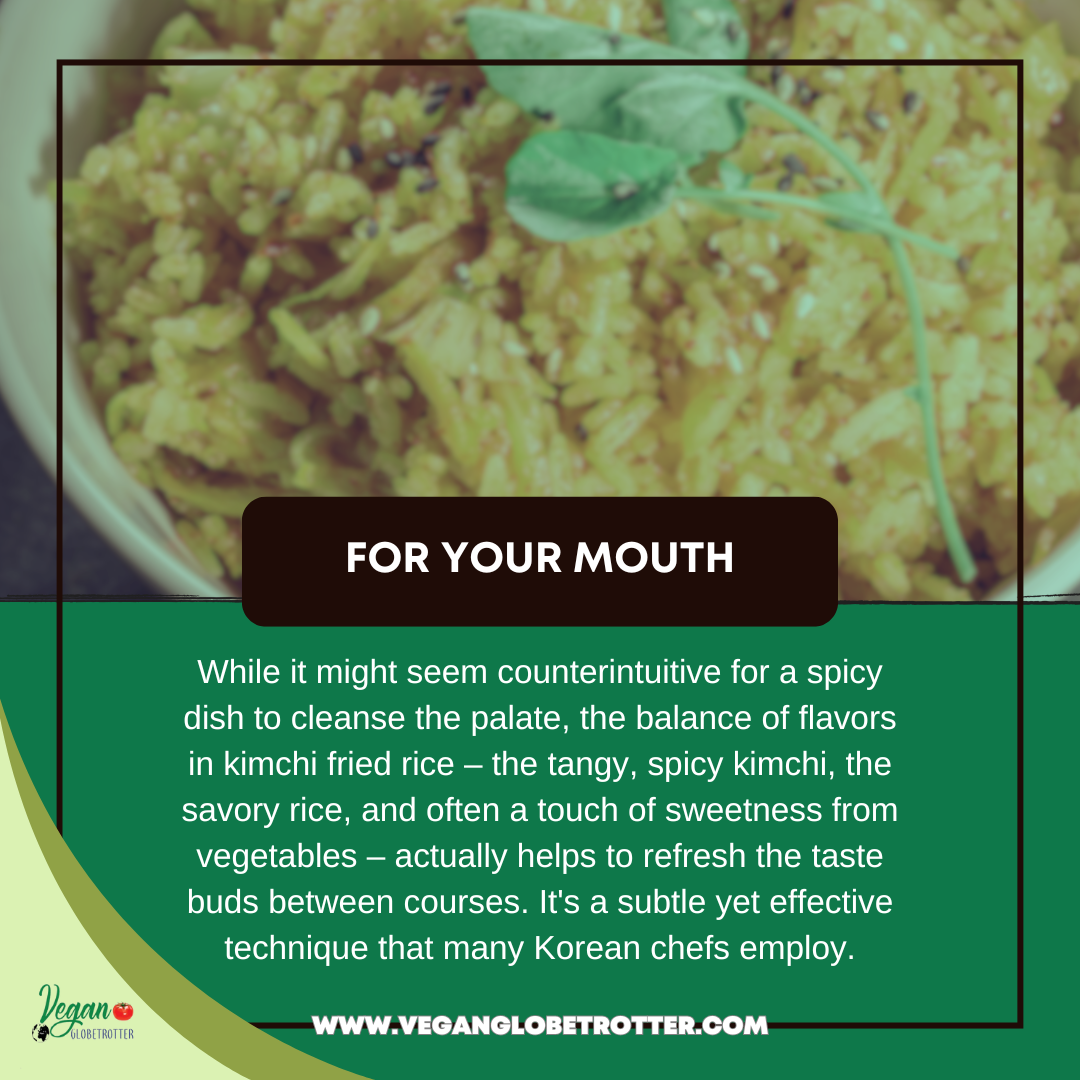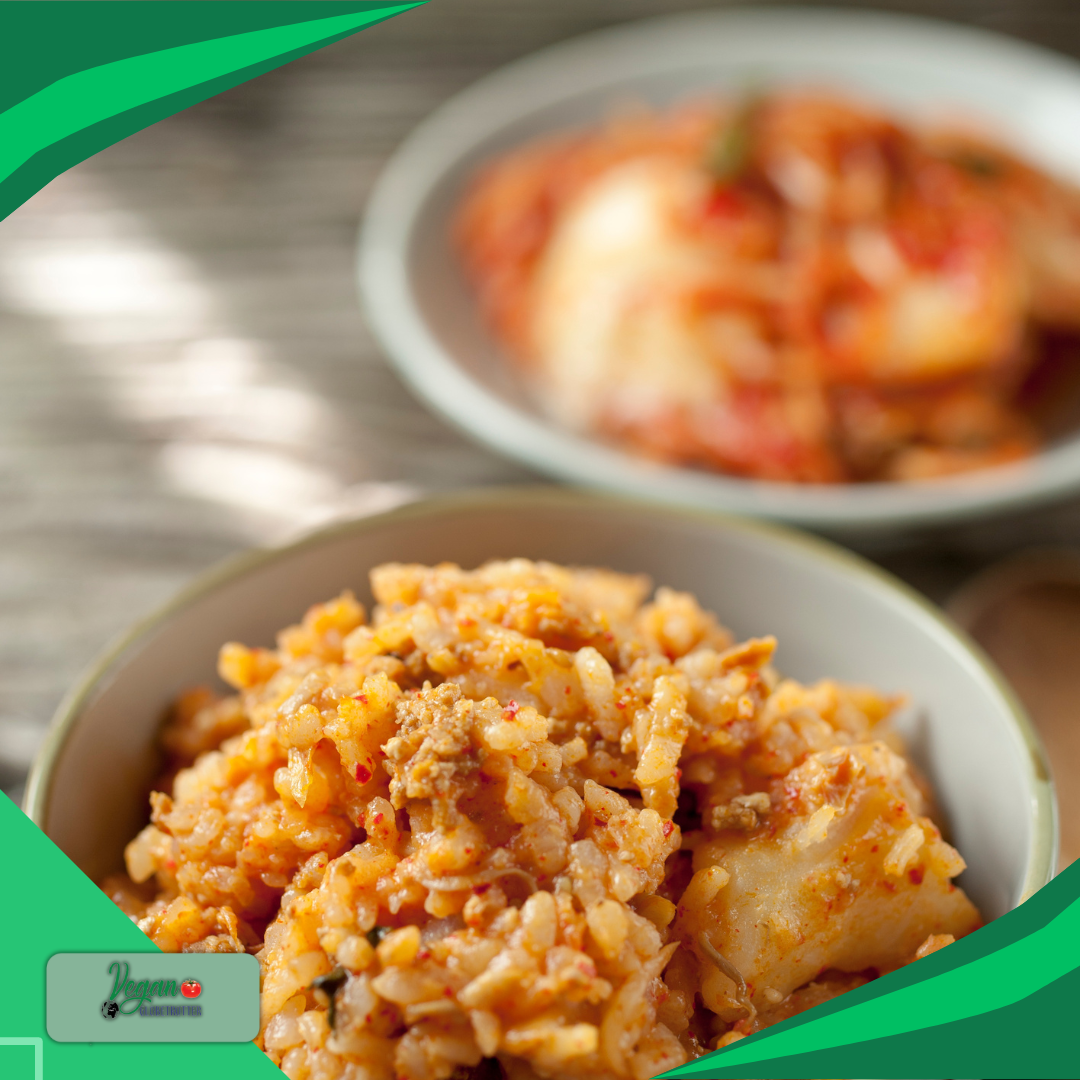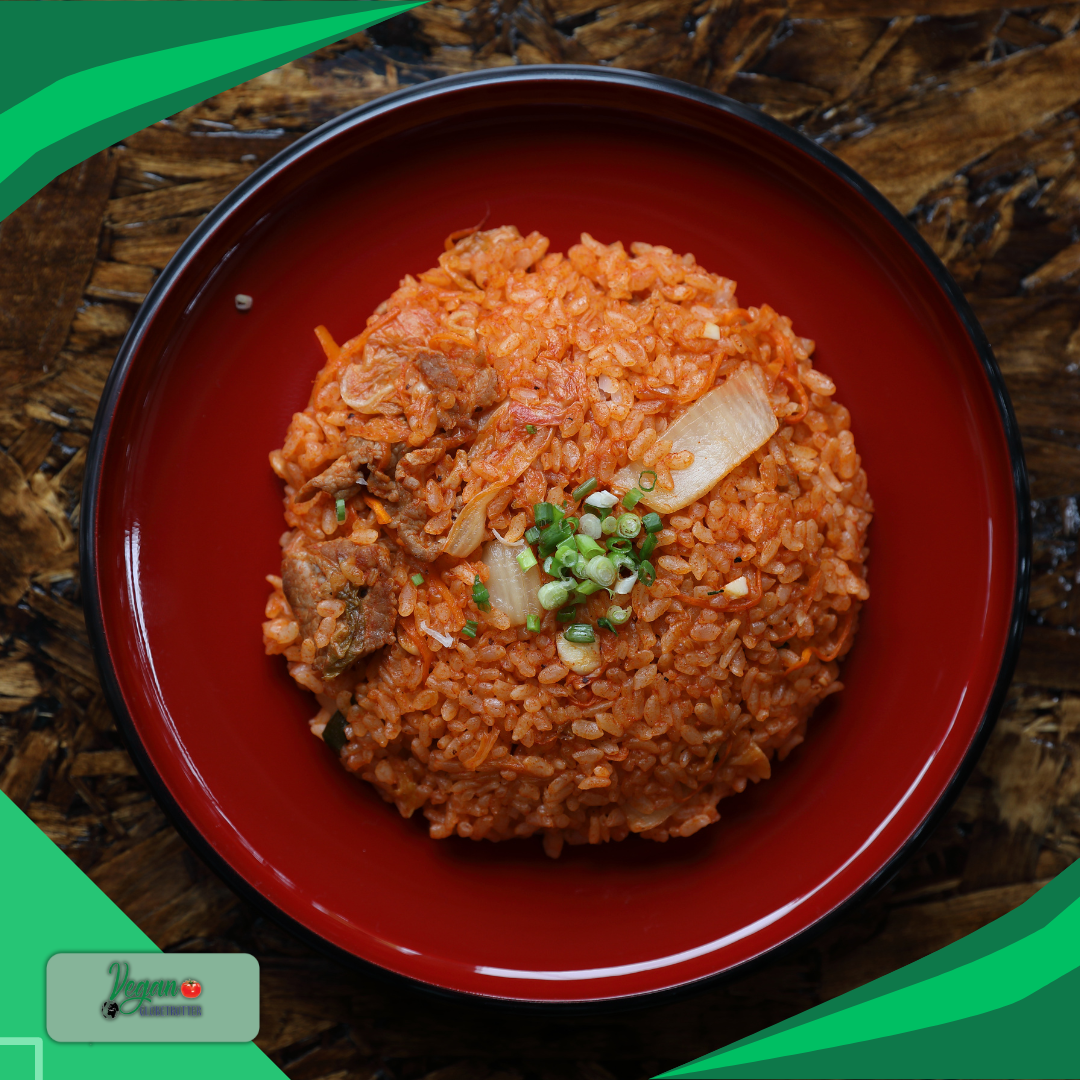Vegan Globetrotter is supported by our audience. When you purchase through one of our links, we may earn a small affiliate commission. As an Amazon Associate I earn from qualifying purchases. Your cost is not affected.
==================
Craving a spicy kick? Let’s dive into making some mouthwatering kimchi rice! This classic Korean dish is a flavor-packed delight that’s not only incredibly easy to prepare but also completely plant-based. Whether you’re cooking up a quick lunch, a satisfying dinner, or even a late-night snack, this vegan version of kimchi fried rice is sure to hit the spot. Ready to turn up the heat in your kitchen? Let’s get cooking!
An Easy And Quick Dish: Kimchi Rice Recipe
Get ready to tantalize your taste buds with a mouthwatering dish that’s quick, easy, and packed with flavor. Kimchi rice is about to become your new favorite meal! This Korean-inspired creation brings together the tangy kick of kimchi with the comforting warmth of rice, creating a perfect harmony of tastes and textures.
You’ll love how simple it is to whip up this delicious dish in just minutes. With a handful of ingredients and a few easy steps, you can transform ordinary rice into an extraordinary meal that’ll have you coming back for seconds. Whether you’re a seasoned cook or just starting out in the kitchen, this recipe is sure to impress. Get ready to discover your new go-to meal for busy weeknights or lazy weekends!

Key Takeaways
- Kimchi rice is a quick, flavorful dish that combines tangy kimchi with comforting rice
- This versatile meal is easy to customize and packed with nutrients
- Kimchi adds probiotics and vitamins, making it a healthy choice for any diet


Savory and Spicy Kimchi Rice: A Flavorful Korean Delight
If you’re a fan of bold flavors and quick meals, kimchi rice is a dish you’ll want to try. This vibrant Korean staple combines the spicy, tangy notes of kimchi with savory rice, creating a comforting and satisfying meal perfect for any time of the day. Whether you’re looking for a hearty side dish or a flavorful main course, kimchi rice is both easy to prepare and irresistibly delicious.

What Is Kimchi Rice?
Kimchi rice, also known as “kimchi bokkeumbap,” is a popular Korean dish made by stir-frying rice with kimchi, a fermented vegetable dish typically made from cabbage and radishes. The result is a dish packed with flavor and texture, thanks to the combination of the kimchi’s tangy heat and the rice’s satisfying heartiness. It’s often topped with additional ingredients like green onions, sesame seeds, and sometimes a fried egg for extra richness.
Key Ingredients
To make a basic kimchi rice, you’ll need the following ingredients:
- Kimchi: The star of the dish. Use well-fermented kimchi for the best flavor.
- Rice: Cooked, day-old rice works best as it’s less sticky and fries nicely. You can use white, brown, or jasmine rice.
- Vegetables: Common additions include chopped onions, garlic, and carrots for extra flavor and crunch.
- Seasonings: Soy sauce, sesame oil, and a touch of sugar balance out the flavors and enhance the dish.
- Toppings: Green onions, sesame seeds, and protein of your choice to finish the dish.
How to Make Kimchi Rice
- Prepare the Ingredients: If you haven’t done so, cook your rice and let it cool. Chop your kimchi and any additional vegetables you plan to use.
- Stir-Fry the Vegetables: Heat some oil in a large skillet or wok over medium heat. Add chopped onions and garlic, and cook until softened and fragrant. If you’re using carrots or other vegetables, add them next and cook until they’re tender.
- Add the Kimchi: Stir in the chopped kimchi and cook for a few minutes until it’s heated through and slightly caramelized.
- Incorporate the Rice: Add your day-old rice to the pan, breaking up clumps as you go. Stir everything together until the rice is evenly mixed with the kimchi and vegetables.
- Season to Taste: Drizzle in some soy sauce and sesame oil, and add a touch of sugar if needed. Taste and adjust the seasoning according to your preference.
- Finish and Serve: Top your kimchi rice with sliced green onions and sesame seeds. Serve hot and enjoy!
Variations and Add-Ons
- Protein: For a vegan option, you can add tofu, tempeh, or any plant-based protein of your choice.
- Spicy Kick: If you love extra heat, add a spoonful of gochujang (Korean red chili paste) or a sprinkle of red pepper flakes.
- Veggies: Feel free to mix in other vegetables like bell peppers, mushrooms, or spinach for more variety and nutrition.
Why Kimchi Rice is Perfect for Plant-Based Eaters
Kimchi rice is a tasty dish you’ll love if you follow a vegan diet. It’s quick to make and full of flavor. The kimchi adds a tangy, spicy kick that will wake up your taste buds. Plus, it’s packed with good-for-you stuff like probiotics and vitamins.
You can easily find or make vegan kimchi to keep this meal 100% plant-based. The best part? You can mix and match veggies to make it your own. Try adding some crispy tofu or your favorite plant protein for extra staying power.
Here’s why kimchi rice is so great for vegans:
- It’s super flavorful without any animal products
- Kimchi is full of probiotics for a happy tummy
- You get lots of vitamins from the fermented veggies
- It’s filling and satisfying
- You can customize it with your favorite add-ins
Kimchi has been around for over 2000 years! It started as a way to keep veggies fresh during cold Korean winters. Now, it’s a big part of Korean food and culture. The spicy red kimchi we know today came about after chili peppers made their way to Korea in the 1500s.
Give kimchi rice a try next time you want something quick and tasty. It’s a great way to add more plant-based meals to your week!

The Story Behind Kimchi
Kimchi has been a staple in Korean cuisine for over 2,000 years. It all started during the Three Kingdoms period (57 BC – 668 AD) when people needed a way to keep their veggies fresh through the long, cold winters. At first, it was just a simple fermented dish.
But things got spicy in the 16th century! Portuguese traders brought chili peppers to Korea, and that’s when kimchi got its signature kick. This new ingredient changed the game, leading to the red, fiery kimchi you know and love today.
Kimchi isn’t just food – it’s a big part of Korean culture. People love it for its unique flavor and health perks. It’s packed with vitamins A, B, and C, plus it’s great for your gut health. And the best part? It’s low in calories but high in fiber, making it perfect if you’re watching your weight.

How Kimchi Can Boost Your Meals
Kimchi is a tasty addition to many dishes. It adds a spicy, tangy kick that can make your meals more exciting. Here are some ways kimchi can improve your cooking:
- Flavor boost: Kimchi’s unique taste can liven up plain rice or noodles. Just mix it in for an instant flavor upgrade.
- Extra nutrients: This fermented food contains vitamins A, B, and C. It’s also high in fiber and low in calories.
- Gut health helper: Kimchi has probiotics that can help your digestion. These good bacteria may improve your overall health.
- Versatile ingredient: You can use kimchi in many ways. Try it in soups, stews, sandwiches, or as a side dish.
- Quick meal fix: Kimchi and rice make a fast, easy meal. It’s perfect when you’re short on time but want something tasty.
Kimchi pairs well with many foods. Try it with:
- Grilled meats (for non-vegans)
- Steamed rice
- Soups and stews
- Noodle dishes
- Savory pancakes
Adding kimchi to your meals can make them more flavorful and healthy. Give it a try and see how you like it!
Kimchi: A Korean Culinary Star
Kimchi is a cornerstone of Korean cuisine, with a rich history of over 2,000 years. Originally, it was a simple method to preserve vegetables through the harsh winters, but today, it’s a staple in Korean culture and dining.
Kimchi is incredibly versatile, making it easy to incorporate into various dishes. You can enjoy it with rice, toss it into soups, or even layer it in sandwiches for an extra punch of flavor. Beyond its taste, kimchi is also a powerhouse of nutrition. It’s loaded with vitamins and probiotics that support a healthy gut, while being low in calories and high in fiber.

Ready to experiment with kimchi in your cooking? Here are a few ideas:
- Kimchi Fried Rice: Mix kimchi with rice and veggies for a quick, flavorful meal.
- Korean BBQ: Add kimchi as a side to grilled meats for a refreshing contrast.
- Kimchi Stew: Use it in stews like Kimchi Jjigae to create deep, savory flavors.
- Kimchi Pancakes: Fry it into crispy pancakes (Kimchi Jeon) for a delicious snack.

Making kimchi rice is easy and rewarding. Simply chop some kimchi, stir-fry it with vegetables, and mix in some cooked rice. Season with salt, pepper, and sesame oil, and you’ll have a delicious meal ready in minutes.
Eating kimchi rice offers numerous health benefits:
- Supports Gut Health: Packed with probiotics that promote a healthy digestive system.
- High in Fiber: Helps with digestion and keeps you feeling full.
- Boosts Immune System: The vitamins and antioxidants strengthen your defenses.
- Weight Management: Low in calories but satisfying, making it great for weight control.
- Heart Health: Contains beneficial nutrients like potassium and antioxidants.
- Nutrient-rich: Provides a variety of essential vitamins and minerals.
- Skin Health: The probiotics and vitamins contribute to clearer skin.
So, the next time you’re in the mood for something tasty and nutritious, give kimchi a try. It’s a delicious way to bring Korea’s bold, vibrant flavors to your table!
How to Make Kimchi Rice
Gathering Your Ingredients
Here’s what you’ll need:
- ½ cup of chopped kimchi
- 1 cup of cooked rice (day-old rice works best for this dish)
- A mix of your favorite veggies (like carrots, peas, or bell peppers)
- Salt and pepper to taste
- 1 tablespoon of sesame oil
- 1 tablespoon of ketchup
- Optional: hot sauce for an extra kick
Start by chopping the kimchi into small, bite-sized pieces. This will ensure it mixes well with the other ingredients.
Cooking the Kimchi
Heat a tablespoon of oil in a large pan or wok over medium heat. Once hot, toss in your mixed veggies and sauté until they’re slightly softened. Then, add the chopped kimchi and stir-fry for 2-3 minutes. This step intensifies the kimchi’s flavor, making your dish extra savory.
Adding the Rice
Next, add the cooked rice to the pan. Stir everything together, making sure the rice is evenly coated with the kimchi and veggies. Continue cooking for another 3-4 minutes until the rice is heated through and slightly crispy on the edges.
Spicing It Up
Now, it’s time to enhance the flavor. Season the dish with salt and pepper to your taste. Add the sesame oil for a nutty aroma, and stir in the ketchup to give the rice a slight sweetness and a deeper red color. If you’re in the mood for something spicy, add a dash of hot sauce.
Serving the Kimchi Rice
Serve your kimchi rice hot, garnished with a sprinkle of chopped green onions for a fresh, vibrant touch. This dish is quick, easy, and packed with flavor—perfect for a speedy meal that’s as nutritious as it is delicious.
Kimchi rice is not only satisfying but also healthy. The kimchi adds a dose of vitamins and probiotics that promote good digestion and overall gut health. Enjoy this tasty, wholesome dish anytime you need a fast and flavorful meal!
Health Perks of Kimchi Rice
Kimchi rice isn’t just tasty – it’s good for you too! This Korean dish packs a punch of flavor and health benefits.
You’ll get a boost of probiotics from the kimchi. These good bacteria help your gut stay happy and healthy. A healthy gut means better digestion and a stronger immune system.
The veggies in kimchi are full of fiber. This helps you feel full and keeps your blood sugar steady. Plus, you’ll get many vitamins like C, A, and B. These keep your body strong and help you fight off sickness.
Kimchi rice is great if you’re watching your weight. It’s low in calories but big on taste, and the spicy kick may speed up your metabolism. Your heart will thank you for this meal. Kimchi has stuff that can lower cholesterol and blood pressure. That’s good news for your ticker!
Want better skin? Kimchi’s got you covered. Its vitamins and antioxidants can help your skin look fresh and healthy.
To make your kimchi rice even healthier, try these tips:
- Use brown rice instead of white
- Add extra veggies
- Throw in some lean protein like tofu.
Give kimchi rice a try! It’s a quick, easy way to treat your taste buds and your body right.
Tasty Kimchi Varieties and Perfect Pairings
Kimchi comes in a variety of styles, each offering its own distinct flavor profile. Whether you prefer the fiery heat of red chili pepper-infused kimchi or the milder, more subtle taste of white kimchi without the spice, there’s a type of kimchi to suit every palate. Some popular varieties include:
- Baechu Kimchi: Made with napa cabbage, this is the most common type of kimchi, known for its spicy and tangy flavor.
- Kkakdugi: This version uses cubed radish, offering a crunchy texture and a slightly sweeter taste.
- Oi Sobagi: Stuffed cucumber kimchi that is crisp, refreshing, and perfect for warm weather.
- Gat Kimchi: Made with mustard leaves, this kimchi has a unique, slightly bitter taste that complements its spiciness.
No matter which type of kimchi you choose, it pairs beautifully with a wide range of dishes.
Kimchi’s versatility is one of its greatest strengths. You can enjoy it as a side dish, mix it into various recipes, or even use it as a condiment to enhance the flavor of your meals.
Fun Fact
Did you know that kimchi rice is not only delicious but also beneficial for your immune system? The probiotics found in kimchi, a key ingredient in this dish, play a crucial role in enhancing your body’s natural defenses. These beneficial bacteria help to support a healthy gut microbiome, which is essential for maintaining a good immune system.
Why You’ll Love Kimchi Rice
Kimchi rice is not just flavorful; it’s also versatile and easy to make. It’s a great way to use leftover rice and kimchi, and it comes together quickly, making it a perfect weeknight dinner option. The balance of spicy, tangy, and savory flavors makes each bite a delight, and the dish is easily customizable to suit your taste preferences and dietary needs.

Whether you’re new to Korean cuisine or a seasoned fan, kimchi rice offers a delicious and authentic taste of Korea that’s sure to become a favorite in your recipe collection. Enjoy it as a main dish or a side, and savor the incredible flavors of this easy-to-make, comforting meal.
Feel free to get creative with toppings. Try adding crispy tofu cubes or sautéed tempeh for an extra protein boost. If you’re looking for a fun twist, wrap the kimchi rice in lettuce leaves for a light, hand-held meal that’s perfect for sharing.
Before you dig in, don’t forget to snap a photo of your dish! Share your culinary creations on social media to impress your friends and family. They’ll be amazed at how quickly you whipped up such a tasty, Korean-inspired meal.
So why wait? Gather your ingredients and try kimchi rice today. Experiment with your favorite veggies, proteins, and toppings to make it your own. Embrace the rich flavors and health benefits of kimchi rice—your taste buds and your body will thank you!

Frequently Asked Questions
Got questions about whipping up a delicious vegan kimchi rice? We’ve got you covered!
What is vegan kimchi rice?
Vegan kimchi rice is a plant-based version of the traditional Korean dish made with kimchi and rice. It omits animal products, focusing on the flavorful combination of fermented kimchi, vegetables, and rice, often enhanced with plant-based seasonings and toppings.
Can I use store-bought kimchi for this recipe?
Yes, you can use store-bought kimchi. Just make sure it’s labeled vegan, as some kimchi may contain fish sauce or other animal products. Check the ingredients list to ensure it meets your dietary preferences.
What kind of rice is best for kimchi rice?
Day-old rice or cold, cooked rice works best because it’s less sticky and fries up more easily. You can use white rice, brown rice, jasmine rice, or even short-grain rice depending on your preference.
Can I make it less spicy?
Yes, you can adjust the spiciness by adding less kimchi or using a milder kimchi variety.
What other vegetables can I add?
Get creative! Try adding carrots, peas, corn, or your favorite veggies.



Don't miss out
when new recipes and information are added!
Join our newsletter for free recipes,
healthy living inspiration, and special offers
You have Successfully Subscribed!